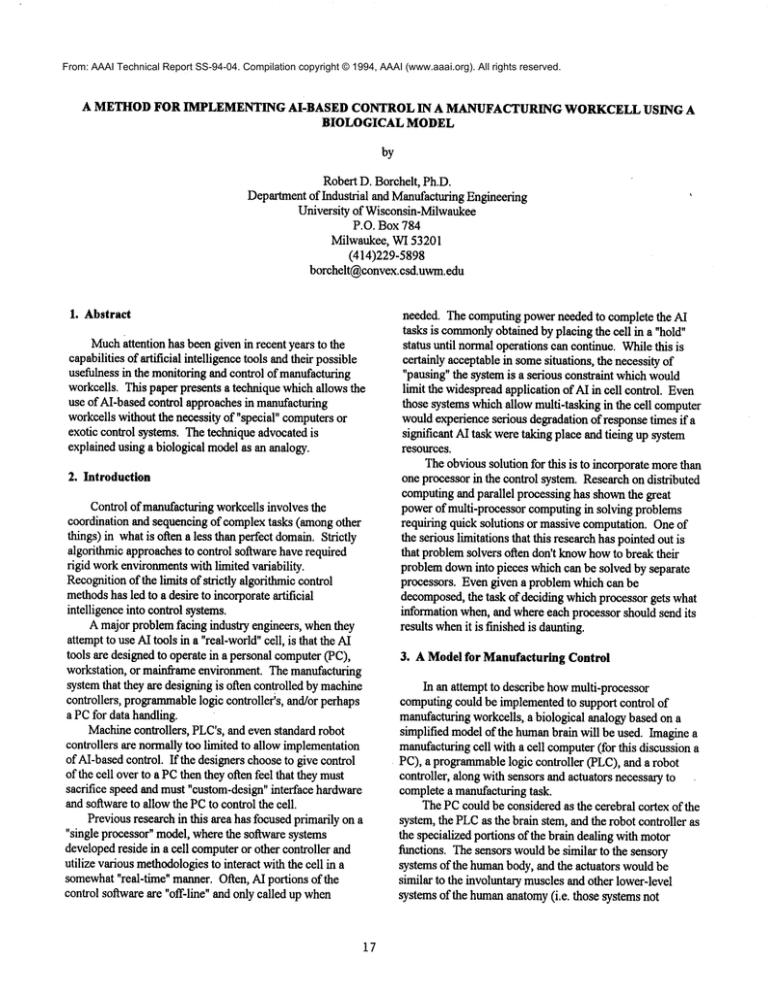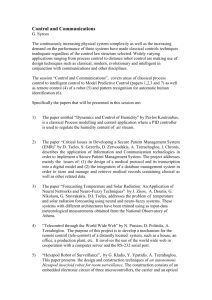
From: AAAI Technical Report SS-94-04. Compilation copyright © 1994, AAAI (www.aaai.org). All rights reserved.
A METHODFOR IMPLEMENTING AI-BASED CONTROLIN A MANUFACTURINGWORKCELLUSING A
BIOLOGICAL MODEL
by
Robert D. Borchelt, Ph.D.
Departmentof Industrial and ManufacturingEngineering
University of Wisconsin-Milwaukee
P.O. Box 784
Milwaukee, WI 53201
(414)229-5898
borchelt@eonvex.csd.uwm.edu
1. Abstract
Muchattention has beengiven in recent years to the
capabilities of artificial intelligence tools and their possible
usefulness in the monitoringand control of manufacturing
workcells. This paper presents a technique which allows the
use of AI-based control approachesin manufacturing
workcells without the necessity of"speeiar’ computersor
exotic control systems. The technique advocatedis
explained using a biological modelas an analogy.
2. Introduction
Control of manufacturingworkcells involves the
coordination and sequencingof complextasks (amongother
things) in whatis often a less than perfect domain.Strictly
algorithmic approachesto control software have required
rigid workenvironmentswith limited variability.
Recognitionof the limits of strictly algorithmiccontrol
methodshas led to a desire to incorporateartificial
intelligence into control systems.
A major problemfacing industry engineers, wlien they
attemptto use AI tools in a "real-world"cell, is that the AI
tools are designedto operate in a personal computer(PC),
workstation, or mainframeenvironment. The manufacturing
systemthat they are designingis often controlled by machine
controllers, programmable
logic controller’s, and/or perhaps
a PCfor data handling.
Machinecontrollers, PLC’s,and even standard robot
controllers are normallytoo limited to allow implementation
of AI-basedcontrol. If the designers chooseto give control
of the cell overto a PCthen they often feel that they must
sacrifice speed and must "custom-design"interface hardware
and softwareto allow the PCto control the cell.
Previousresearch in this area has focusedprimarily on a
"single processor" model, wherethe software systems
developedreside in a cell computeror other controller and
utilize various methodologies
to interact with the eeUin a
somewhat"real-time" manner.Often, AI portions of the
control softwareare "off-line" and only called up when
17
needed. The computingpower needed to complete the AI
tasks is commonly
obtained by placing the cell in a "hold"
status until normaloperations can continue. Whilethis is
certainly acceptablein somesituations, the necessity of
"pausing" the systemis a serious constraint whichwould
limit the widespreadapplication of AI in cell control. Even
those systems whichallow multi-tasking in the cell computer
wouldexperience serious degradationof response times if a
significant AI task were taking place and tieing up system
resources.
Theobvioussolution for this is to incorporate morethan
one processor in the control system. Researchon distributed
computingand parallel processing has shownthe great
powerof multi-processor computingin solving problems
requiring quick solutions or massive computation. One of
the serious limitations that this researchhas pointedout is
that problemsolvers often don’t knowhowto break their
problemdowninto pieces which can be solved by separate
processors. Even given a problem which can be
decomposed,the task of deciding which processor gets what
information when,and whereeach processor should send its
results whenit is fmishedis daunting.
3. A Model for ManufacturingControl
In an attempt to describe howmulti-processor
computingcould be implementedto support control of
manufacturingworkcells, a biological analogy based on a
simplified modelof the humanbrain will be used. Imaginea
manufacturingcell with a cell computer(for this discussion
PC), a programmable
logic controller (PLC), and a robot
controller, along with sensors and actuators necessaryto
complete a manufacturingtask.
The PCcould be consideredas the cerebral cortex of the
system, the PLCas the brain stem, and the robot controller as
the specialized portions of the brain dealing with motor
functions. The sensors wouldbe similar to the sensory
systems of the humanbody, and the actuators wouldbe
similar to the involuntary musclesand other lower-level
systems of the humananatomy(i.e. those systems not
requiring free or gross motorskills).
Assumingsuch a model, the tasks which should be
assigned to each processor can be discerned (part of the
reason for using the model)basedon the perceivedlevel at
whichthe humanbrain wouldhandle a similar task.
Usingthis model, the PCshould be responsible for
controlling "higher level" problemssuch as assembly
planning, error recovery, and other "knowledgeintensive"
tasks. It is a moresophisticated"thinker" than the other
processors, and can support AI-basedtools to handle these
complexdecisions. Becauseit is handling larger "problems"
it will respondslower and should not be "interrupted" by
"housekeepingdetails".
The PLC,on the other hand, should be responsible for
handling"instinctual" or involuntaryreactions like the
implementation,and subsequentfeedthrough of, an
emergencystop. Anotherexamplemight be the timing of a
pallet transfer. The sequenceof operations for a pallet
transfer are well defined, simple, and easily accomplishedby
a PLC.In addition, the task of transferring the pallet froma
mainconveyorinto a transfer station is not one that can be
closely controlled by an automatedsystem. The success
and/or failure of a pallet transfer is muchmoredependenton
the physical dimesionsand tolerances of the material
handlingcomponents
than on the instructions sent to it buy
the controller. Ira problemdevelopsin the transfer, there is
not likely to be muchthat an "intelligent" controller can do
about it. These "housekeepingdetails" are time consuming
but predictable and do not require the higher level
"reasoning"ability of the PC.Delegatingthese tasks to the
PLCflees up the PCfor its higher level duties. Theparallel
nature and speed with whicha PLCcan detect a situation and
implementa responsemakeit ideal for time-critical tasks.
The "parallel" nature also makesa PLCwell suited for
handling the manydetails which must be simultaneously
considered during normaloperation.
Finally, the robot controller should be used to focus on
the tasks for whichit was originally designed. Namely,
controlling the actions of the mechanicalarm. Whilerobot
controllers often contain user definable inputs and outputs
whichcan be used to sequenceoperations within a
robot-centeredcell, they are not well suited for the role of
cell controller. Sequencingtasks slow downoperation of the
robot and the ability of standardrobot languagesto express
sequencingconceptsis limited at best. If task planning,
gripper control, sensor monitoring,etc., is all givenover to
the other processorsin the system,then the robot controller
can concentrate on quick and accurate responses to
movementcommands.Writing robot programs in such an
environment
is greatly simplified as well.
Anyspecialized controller could be incorporated in a
similar fashion. Ira machinevision system
is part of the
sensor array, then the vision systemcomputershould be
focused on processing the video imageand providing a
18
simplified abstraction. The guiding principles are foundin
howthe brain handles similar tasks (or at least howwethink
it does). The analogyis general enoughto be applicable in
most manufacturingcontrol problems, but can be applied
specifically enoughto be useful.
4. Conclusions
Existing research often focuses on improvingrobot
languagesor robot controllers in order to implementAIbased control schemesin robotic workcells. Most robot
purchasersare industrial companieswhichare unwilling to
pay for the "addedcapabilities" whichwouldbe part of such
an "improved"robot system. Whetherthis occurs due to
ignoranceof the potential advantagesof such a system, or
dueto an actual lack of the needfor these capabilities, is
beside the point. The fact is that robot manufacturerswill not
offer these "features" until the customersstart demanding
them.
Havinggeneralized about "most"robot purchasers, it is
nownecessary to address the aggressive and forwardthinking minority. Somecompaniesare exploring AI-based
control, and they have to do it with equipmentmanufactured
today. It is possible to do so, and one approachhas been
explained here. The important concepts are not found in the
specific discussion of whichtype of processor and/or device
is given a certain task. The capabilities of each "robot
controller" and "PLC"varies fromone vendorto the next.
Rather, the importantconceptsare found in the division of
tasks amongcooperating processors, with information being
available whereneeded. The tradeoffs betweenspeed of
decision-makingand complexityof the decision are
important. It is not necessaryfor the "Ar’ portion of the
control systemto consider all decisions. Onthe other hand, it
is necessaryfor the AI portion to understandthe effects of
those decisions and be able to notice whenthey cause errors.
TheAI portion of a controller should be able to over-ride the
"lower-level" decision makerif it deemsthat to be necessary,
just like the brain can makeyou"hold your breath" even
though you need air. The technologies involved will vary
fromsystemto system, but the idea of structuring the levels
of decision-makingaccording to a biological modelseems
both feasible and easily understandable.
The resulting control systemshould be both powerful
and fast, and wouldtake advantageof the strengths of each of
the controller platforms involved. Theresponse times of the
systemwouldbe appropriate to the tasks encounteredrather
than "uniformlyfast" but required to be simple, or "uniformly
slow" but "thoroughlyconsidered". Overall, this model
should provide a guideline for implementing
multiple-processor computingin the manufacturingcontrol
environment.



